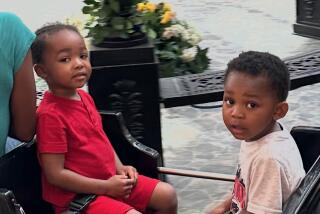Surgery Is Weighed for Siamese Twins
- Share via
SAN DIEGO — When Miguel Angel Morales first saw his newborn daughters, the shock was so great he could not bear to look.
The infants, born at a small clinic in Tijuana, are connected from the navel to the midchest in a rare condition known to doctors as conjoined thoracopagus but to the rest of the world as Siamese twins.
But now the shock has turned to love and Morales and his wife, Maria Luisa Espinoza, are spending as much time as possible with their tiny daughters, Sarah and Sarahi, as they undergo tests at Children’s Hospital here that could determine if either twin could survive surgical separation.
“I wish I could be with them all the time,” Morales, 30, a mechanic who makes less than $50 a week and has no medical insurance, said Monday at the hospital.
“We’re frightened but we’re also very hopeful,” said Espinoza, 33. The couple have four other children: sons 3 and 15, and daughters 7 and 13.
Doctors have at least a glimmer of hope that both infants might survive if surgery is attempted. If so, it would be only the second time that twins joined at the chest have been separated and both have lived.
A more likely outcome, however, is that doctors will approach surgery knowing that the weaker of the twins will not survive.
“We are aware we might have to make a decision like that,” Morales said through a translator. “We are praying.”
Two facts bode well for the twins. Each baby has her own heart although there is a partial connection. And while they share a liver, it is an oversized liver that might be able to be surgically divided.
On Monday, the infants were undergoing cardiac catheterization to give doctors a picture of how many cardiac arteries the two share, a crucial medical fact. Doctors hope to know in a day or two what, if any, surgical options are available.
One estimate is that conjoined twins occur once every 100,000 births, with 60% being stillborn and most of the others dying within a few days. Medical journals say that less than 500 sets of Siamese twins are known to have survived more than a few months worldwide.
Not all parents of such twins are up to making a decision to attempt a surgery in which it is known that only one child can survive. In 1982, a couple with twins conjoined at the internal organs opted against separation surgery at Children’s Hospital and both children died within months, doctors said.
The twins were born by caesarean section at the seven-bed Hospital Santa Maria near the family home on Jan. 12 and rushed Friday to the intensive care unit at Children’s Hospital. They are not thought to be in imminent danger. Doctors believe they have sufficient time to run tests and consult with the parents.
“We believe we have a window of opportunity,” said Dr. Michael L. Segall, head of neonatology at Children’s Hospital. “But it’s impossible to determine the duration of that window.”
Both hearts have deficiencies, although one is stronger than the other. “One twin is, in fact, providing some support for the other twin,” Segall said.
Segall said that a review of medical literature showed only nine reported cases of twins joined at the chest being separated. Of those, he said, in only one case did both babies survive. In the others, one or both died, he said.
Conjoined twins occur when a fertilized egg separates into two but not completely. Because there are a variety of ways such twins can be joined, such as at the head, at the intestines or at the bowels, little medical literature exists to use as a guide for specific surgical procedures.
Segall said advice is being sought by specialists from throughout the country while Children’s Hospital assembles its own team of doctors and nurses to attempt a separation surgery, should that become medically warranted and is in accordance with the parents’ wishes.
After the twins had been discharged from the clinic in Tijuana, a desperate Morales went to several hospitals in the Mexican border city looking for help. He even made an appeal on Tijuana television, which brought the family to the attention of Children’s Hospital.
Because the family does not qualify for medical insurance, doctors at Children’s Hospital are donating their services. Also, a fund has been set up for the infants’ care through the Children’s Hospital Foundation (619 495-7749).
Espinoza had little or no prenatal care during her pregnancy, but Segall said that would have not have made a difference.
Morales said that when the twins are not undergoing tests he sits and watches over them. “I see my other children in their faces,” he said.
More to Read
Sign up for Essential California
The most important California stories and recommendations in your inbox every morning.
You may occasionally receive promotional content from the Los Angeles Times.













